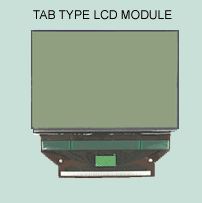COG & TCP Chip-On-Glass – is one of the high-tech mounting methods that
uses Gold Bump or Flip Chip IC’s, and implemented in most compact
applications. Chip-On-Glass integrated circuits were first introduced
by Epson. In flip-chip mounting, the IC chip is not packaged but is
mounted directly onto the PCB as a bare chip. Because there is no
package, the mounted footprint of the IC can be minimized, along with
the Advantages: Very space economical. Chip-On-Glass LCD modules can be as thin
as 2 mm. COG can only be used at a certain resolution level where the lines
are not too fine. At very fine pitches COG becomes difficult to
test, and TAB is the preferred approach. |
|
| Glossary | LCD Module | LCD Panel | Backlight | IC | Top |
 required
size of the PCB. This technology reduces a mounting area and is better
suited to handling high-speed or high-frequency signals.
required
size of the PCB. This technology reduces a mounting area and is better
suited to handling high-speed or high-frequency signals.